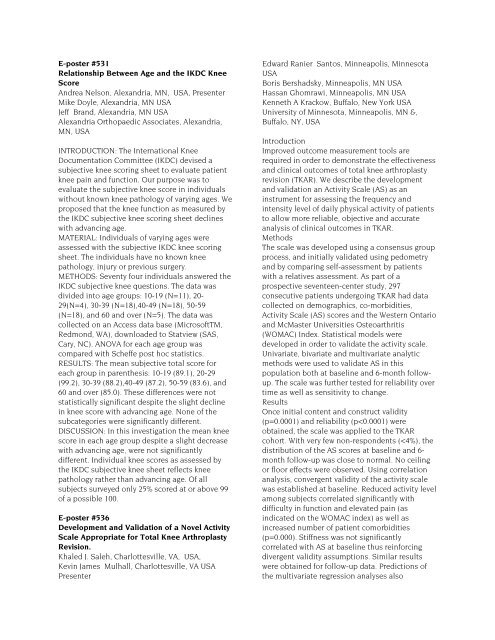POSTER ABSTRACTS - ISAKOS
POSTER ABSTRACTS - ISAKOS
POSTER ABSTRACTS - ISAKOS
Create successful ePaper yourself
Turn your PDF publications into a flip-book with our unique Google optimized e-Paper software.
E-poster #531<br />
Relationship Between Age and the IKDC Knee<br />
Score<br />
Andrea Nelson, Alexandria, MN, USA, Presenter<br />
Mike Doyle, Alexandria, MN USA<br />
Jeff Brand, Alexandria, MN USA<br />
Alexandria Orthopaedic Associates, Alexandria,<br />
MN, USA<br />
INTRODUCTION: The International Knee<br />
Documentation Committee (IKDC) devised a<br />
subjective knee scoring sheet to evaluate patient<br />
knee pain and function. Our purpose was to<br />
evaluate the subjective knee score in individuals<br />
without known knee pathology of varying ages. We<br />
proposed that the knee function as measured by<br />
the IKDC subjective knee scoring sheet declines<br />
with advancing age.<br />
MATERIAL: Individuals of varying ages were<br />
assessed with the subjective IKDC knee scoring<br />
sheet. The individuals have no known knee<br />
pathology, injury or previous surgery.<br />
METHODS: Seventy four individuals answered the<br />
IKDC subjective knee questions. The data was<br />
divided into age groups: 10-19 (N=11), 20-<br />
29(N=4), 30-39 (N=18),40-49 (N=18), 50-59<br />
(N=18), and 60 and over (N=5). The data was<br />
collected on an Access data base (MicrosoftTM,<br />
Redmond, WA), downloaded to Statview (SAS,<br />
Cary, NC). ANOVA for each age group was<br />
compared with Scheffe post hoc statistics.<br />
RESULTS: The mean subjective total score for<br />
each group in parenthesis: 10-19 (89.1), 20-29<br />
(99.2), 30-39 (88.2),40-49 (87.2), 50-59 (83.6), and<br />
60 and over (85.0). These differences were not<br />
statistically significant despite the slight decline<br />
in knee score with advancing age. None of the<br />
subcategories were significantly different.<br />
DISCUSSION: In this investigation the mean knee<br />
score in each age group despite a slight decrease<br />
with advancing age, were not significantly<br />
different. Individual knee scores as assessed by<br />
the IKDC subjective knee sheet reflects knee<br />
pathology rather than advancing age. Of all<br />
subjects surveyed only 25% scored at or above 99<br />
of a possible 100.<br />
E-poster #536<br />
Development and Validation of a Novel Activity<br />
Scale Appropriate for Total Knee Arthroplasty<br />
Revision.<br />
Khaled J. Saleh, Charlottesville, VA, USA,<br />
Kevin James Mulhall, Charlottesville, VA USA<br />
Presenter<br />
Edward Ranier Santos, Minneapolis, Minnesota<br />
USA<br />
Boris Bershadsky, Minneapolis, MN USA<br />
Hassan Ghomrawi, Minneapolis, MN USA<br />
Kenneth A Krackow, Buffalo, New York USA<br />
University of Minnesota, Minneapolis, MN &,<br />
Buffalo, NY, USA<br />
Introduction<br />
Improved outcome measurement tools are<br />
required in order to demonstrate the effectiveness<br />
and clinical outcomes of total knee arthroplasty<br />
revision (TKAR). We describe the development<br />
and validation an Activity Scale (AS) as an<br />
instrument for assessing the frequency and<br />
intensity level of daily physical activity of patients<br />
to allow more reliable, objective and accurate<br />
analysis of clinical outcomes in TKAR.<br />
Methods<br />
The scale was developed using a consensus group<br />
process, and initially validated using pedometry<br />
and by comparing self-assessment by patients<br />
with a relatives assessment. As part of a<br />
prospective seventeen-center study, 297<br />
consecutive patients undergoing TKAR had data<br />
collected on demographics, co-morbidities,<br />
Activity Scale (AS) scores and the Western Ontario<br />
and McMaster Universities Osteoarthritis<br />
(WOMAC) Index. Statistical models were<br />
developed in order to validate the activity scale.<br />
Univariate, bivariate and multivariate analytic<br />
methods were used to validate AS in this<br />
population both at baseline and 6-month followup.<br />
The scale was further tested for reliability over<br />
time as well as sensitivity to change.<br />
Results<br />
Once initial content and construct validity<br />
(p=0.0001) and reliability (p
















